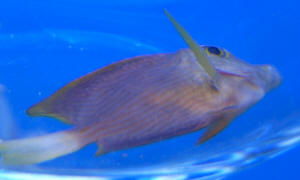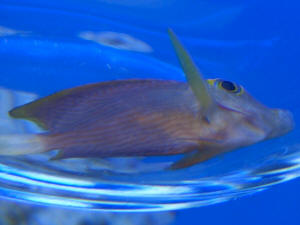|
FAQs about Bristletooth Tangs, Genus
Ctenochaetus
Nutritional Disease FAQs on
Bristlemouth Tang Disease:
Ctenochaetus Disease 1,
Ctenochaetus Disease 2,
FAQs on Bristlemouth Tang Disease by Category:
Diagnosis,
Environmental,
Social,
Trauma,
Pathogenic
(plus see Tangs/Rabbitfishes &
Crypt,
Genetic,
Treatments
Related Articles: Ctenochaetus, Naso,
Related FAQs: Ctenochaetus Disease 2, Tangs/Rabbitfishes & Crypt, Ctenochaetus Tangs 1, Ctenochaetus Tangs 2, Ctenochaetus Identification, Ctenochaetus Behavior, Ctenochaetus Compatibility, Ctenochaetus Selection, Ctenochaetus Systems, Ctenochaetus Feeding, Ctenochaetus Reproduction, Surgeons In General, Tang
ID, Tang
Behavior, Compatibility, Systems, Feeding, Disease,
|
|
Surgeonfishes: Tangs for Marine Aquariums
Diversity, Selection & Care
New eBook on Amazon: Available
here
New Print Book on Create Space: Available
here
by Robert (Bob) Fenner |
 |
| Sick Yellow-Eyed Tang 8/31/05 Hey there,
<Hi> Great website, but it's a little hard to navigate
and search. <Do you have (specific) suggestions on how we might
improve these aspects?> Good resource nevertheless. I
wanted to seek some professional advice about my sick yellow-eyed
tang. I purchased it about 3-4 weeks ago. My
60 gallon tank has been cycled through for a few weeks before that,
and I introduced a small spotted damsel to start the
bio-cycle. When I purchased the yellow-eyed tang, I also
introduced a small clown fish at the same time. I
secluded the damsel in fear that it would be too aggressive for the
clown and the tang, but after rearranging the live-rock and
releasing the damsel after a few days, they seemed to get along
quite well. Very recently within the past 24 hours, my yellow-eyed
tang had secluded itself under a large piece of live-rock and
didn't come out of its hiding place. Usually, it
would be waiting with the other two fish for me to feed
them. Before yesterday, the tang seemed to be swimming
very normally, and I fed it Formula 2 pellets w/
garlic. He seemed to be eating those fine, but
wasn't too keen on the seaweed sheets. <Takes time...
familiarity> I did an immediate 10-15% water change, and lifted
the live-rock it was hiding under, only to find the tang on its
side and breathing heavily. I do not have a quarantine tank, so I
had to seclude it in a small glass fish-bowl that is semi submerged
in my 60-gallon tank. My only other idea was to place it
in the homemade sump, but was afraid of the water pump catching the
tang in its vacuum inlets. I've attached two
pictures of the tang. It is still breathing and still
has normal coloration. The only other symptoms are that it looks
anorexic (it has only looked this way within the last 24 hours),
and seems to swim normally when in a gentle
current. Any help/advice is appreciated. <Mmm,
well, this specimen is badly emaciated... starved... So, at least
part of the answer here is poor handling prior to your receiving
the fish... "It has a low index of fitness"... this
coupled with stress of moving, a new tank... I would return it to
the main tank, and hope it recovers of its own accord... Do take a
look at pix of other/healthy Ctenochaetus species... notice how
much more well-fleshed they are. Yours is way too skinny. Bob
Fenner> |
|
 
|
- Kole Tang Changing Colors - Hi there how are you? <I am
well, thanks for asking.> I have a question or two for you. I
purchased a Kole tang about a week ago at a local pet shop it looked
healthy it was continually eating algae off the live rock in the tank
and with further inspection I took him home. After a day or so it
started to eat I tried a variety of foods including dried see weed,
brine shrimp, blood worms and a frozen seaweed variety angel formula.
<As an FYI - Angel Formula is actually a sponge based food for
larger angels... not so much sea weed in there.> After about four
days I noticed some blotches on his sides I have had many battles with
marine ich before and I know this isn't it. <Could be for a
variety of reasons, but I suspect your problems with Ich would be due
to the fact that you didn't quarantine your fish before placing
them in the system. Please read up on this here: http://www.wetwebmedia.com/quaranti.htm
> These blemishes seem to be below the surface mostly seen under
bright light, these blotches have spread to the head area as well they
don't fall off and they don't look fuzzy like fungus. <These
fish can change their colors depending on mood, time of day, etc...
most likely it is under stress from the move to your system and is just
feeling out of sorts. It will take a couple of weeks to a month for
this fish to feel at home.> The tang is still very active but is a
finicky eater it seems to be feeding off the rock and some areas of the
glass where algae has started to form. I am wondering if It is Stress
that is causing this any suggestions. <Yes... stress - give it time,
be patient.> He is housed in a 72 gallon tank with a Lemonpeel
angel, a blue devil damsel, two common clowns about an inch long, a
purple Pseudochromis small as well, and a very small tomato clown. It
seemed to quarrel with the blue devil damsel for a while but now it
seems ok. All other fish in the tank are feeding and have a clean bill
of health. If you have any suggestions please E mail me back. Thank you
Stan N. <Cheers, J -- >
Surgeonfishes: Tangs for Marine Aquariums
Diversity, Selection & Care
New eBook on Amazon: Available
here
New Print Book on Create Space: Available
here
by Robert (Bob) Fenner |
 |
|
|

